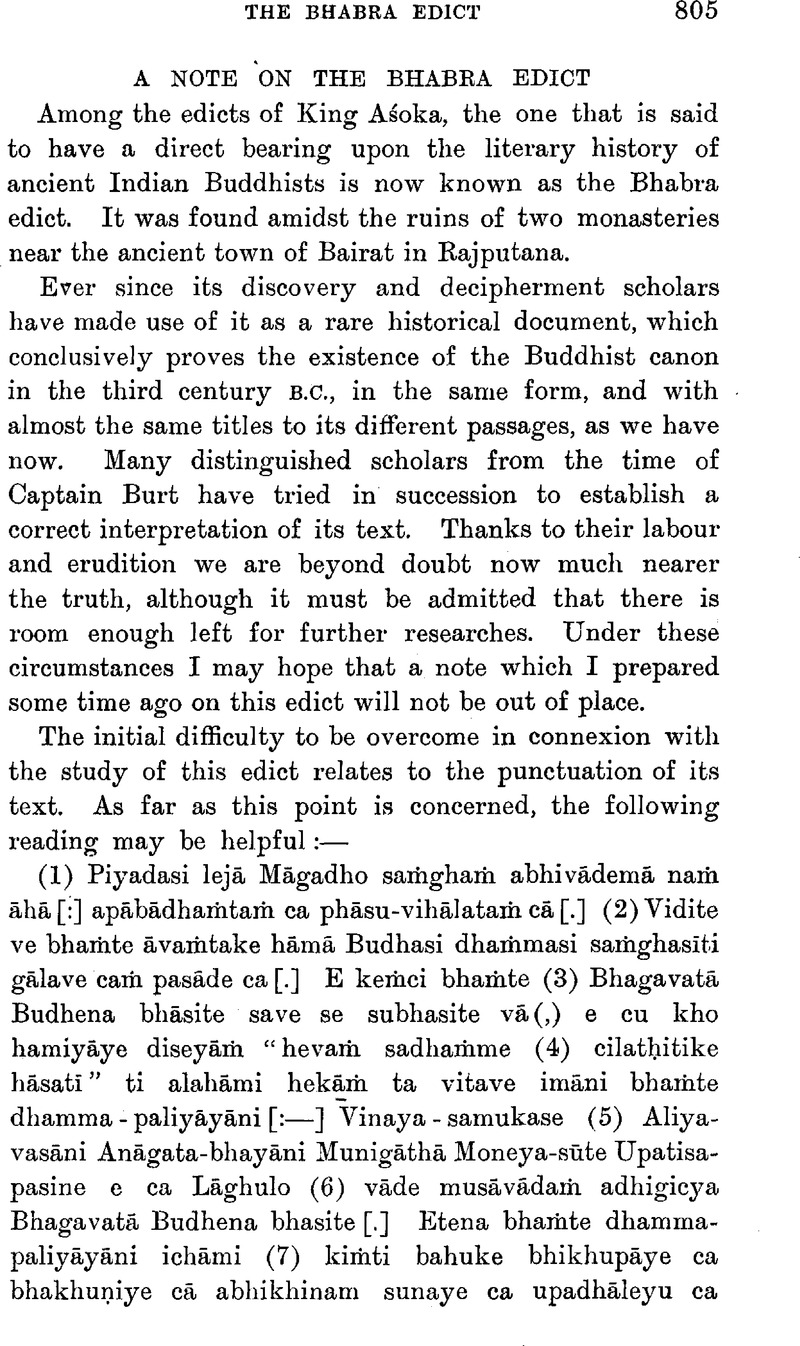Article contents
A Note on the Bhabra Edict
Published online by Cambridge University Press: 15 March 2011
Abstract

- Type
- Miscellaneous Communications
- Information
- Copyright
- Copyright © The Royal Asiatic Society 1915
References
page 806 note 1 I fully agree with Dr. Bloch in taking Māgadho in the nominative, agreeing with lejā, and not in the accusative, agreeing with saṁghaṁ (MrSmith, Vincent's Asoka, 2nd ed., p. 153)Google Scholar. Cf. “Rājā bhante Māgadho Ajātasattu vedehiputto bhagavato pāde sirasā vandati, appābādham … phāsuvihārañ ca pucchatîti Evañea vadehi …” (Mahāparinibbāṇa-suttanta, P.T.S., D. vol. ii, pp. 72–3).
page 806 note 2 Also abhivādiya naṁ and abhivādeyyānaṁ.
page 806 note 3 Cf. “Abhiññāya ahaṁ bhikkhave dhammaṁ desemi”, quoted in the Kathāvatthu, , p. 561Google Scholar. Cf. Dīgha-nikāya, , i, 12Google Scholar; Aṅguttara, , ii, 1Google Scholar, etc. In the Ṛig-veda, also in Pāṇini, ahamyu, “egotistic,” occurs as an adjective derived from ahamyati, “he is egotistic.” A noun of quality to this, Dr. F. W. Thomas seems incḻined to think, would be ahamyā, “egotism” = asmitā, of which hamiyāye would be instrumental— “with egotism” or “presumptuously”.
page 806 note 4 Cf. Pali future forms of √bhū (to be) such as hessati, hohiti, hehiti.
page 806 note 5 The saṇgīti-suttanta, Dīgha-nikāya, , vol. iii.Google Scholar
page 806 note 6 The Aṅguttara-nikāya, , iii, 105–8.Google Scholar
page 806 note 7 The Sutta-nipāta, , 206–20.Google Scholar
page 806 note 8 The Itivuttaka, , 67Google Scholar; Anguttara-nikāya, , i, 272.Google Scholar
page 806 note 9 The Majjhima-nikāya, , i, 414–20.Google Scholar
page 807 note 1 Sans. Abhidhīyatām.
page 808 note 1 Buddhist India, p. 170.Google Scholar
page 808 note 2 See Indices, Aṅguttara-nikaya, , v, p. 366.Google Scholar
page 808 note 3 Ibid., v, p. 195.
page 808 note 4 The Vinaya-pitaka, edited by DrOldenberg, , vol. ii, p. 156.Google Scholar
page 810 note 1 Dialogues of the Buddha, pt. ii, pp. 87–9.
page 810 note 2 The Sutta-nipāta, , iv, No. 16, p. 176.Google Scholar
- 1
- Cited by


